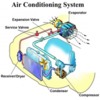quote:
Originally posted by larryw:
Would someone please elaborate on flushing solvents and methods?
All I've ever done was to remove one "component" of the system at a time, flush it out with an aerosol spray can of solvent that air dries leaving no residue (like contact cleaner), and then blow it out with compressed air. Most of the "gunk" in the system will be trapped in the receiver on the outlet of the condenser. It usually has a filter of some sort in it, and a pack of drying agent to absorb water. That's why the receiver should be replaced when ever the system is opened up. I've seen expansion valves with crud lodged in their inlet too. Some expansion valves have screens at the inlet.
quote:
Originally posted by larryw:
How about flushing and refilling the sumps in the compressors?
If the oil looks clean just top it off with the same type of oil. If the oil is dirty flip the compressor over and let it gravity drain, then refill with fresh oil.
quote:
Originally posted by larryw:
And another situation: How would one go about recharging a currently operating system opened for maintenance reasons? For example, I want to replace an iffy looking hose in my car at the receiver/dryer. I cracked the fitting open with a wrench and she has plenty of pressure and the gas seems to be carrying lots of oil too. I quickly retightened the fitting.
To replace any part of the system you have to bleed off the Freon. Of course, in these days you're supposed to capture the Freon rather than bleeding it to atmosphere. That can be accomplished with an empty tank and the vacuum pump. You'll have no way of knowing how much of the compressor oil is lost during your bleeding procedure. After you replace the part you'll have to measure the amount of oil in the compressor with a "wire dipstick" and top off what is lost, or drain the compressor and refill with the proper amount. Afterwards draw the system down and perform the procedure I've already described. You see, Freon has an affinity for moisture, it will absorb moisture from the air. So you have to draw the system down to a very high vacuum for a couple of hours to boil off any moisture that made its way into the system while it was opened to atmosphere (water boils at room temp under a vacuum).
quote:
Originally posted by larryw:
And also, if the compressors have sumps to carry their own oil, what are the small pressurized cans of R12 oil fed in through the charging manifolds supposed to do? There are no moving parts elsewhere in the system that require oil, are there?
As you found out when you cracked the fitting on your system the compressor sumps are not isolated from the system. You're right, only the compressor needs the oil, but the oil is carried by the Freon throughout the system when the system is in operation. It is assumed that as Freon leaks from the system a small amount of oil is lost too, you've probably noticed the place where Freon is leaking is usually covered in oil. So the small cans of Freon have a small amount of oil in them to replenish the oil that is assumed to have been lost. The replacement oil will circulate through the system, and the majority will find its way to the compressor and stay there.


